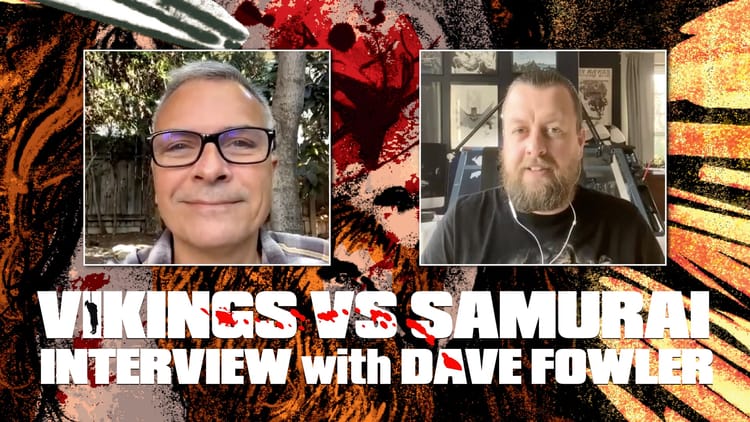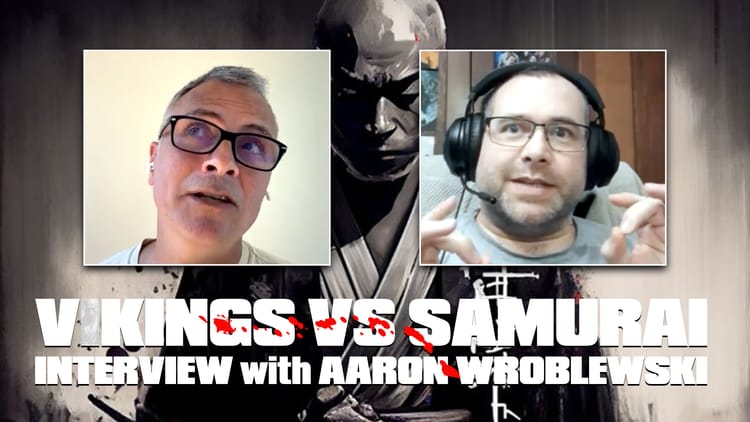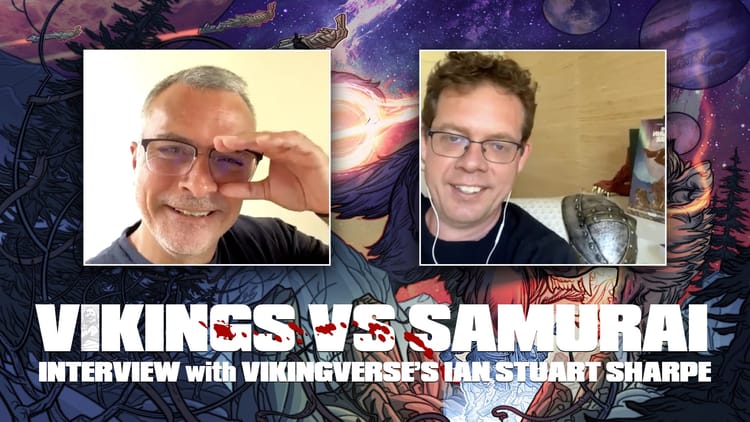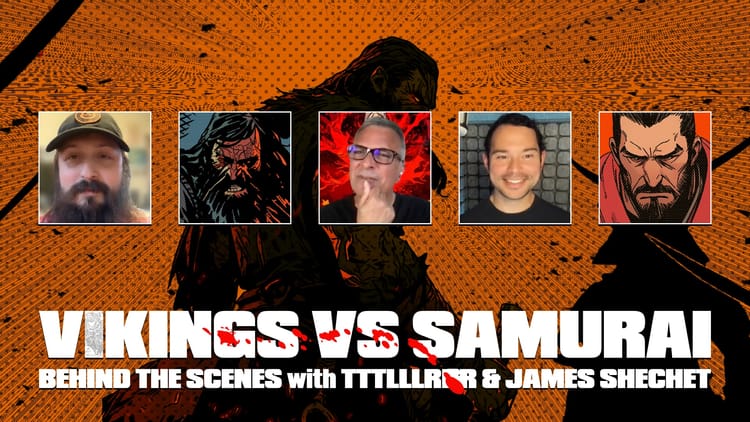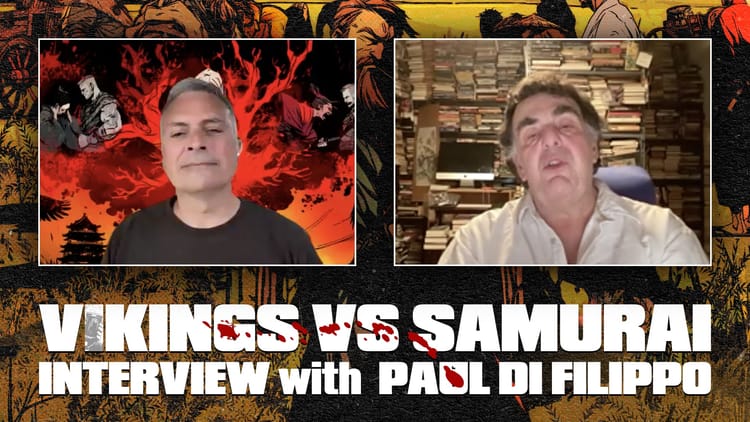A Chat with Max Hoven

VIKINGS vs SAMURAI began as a whim; make a webcomic about something kick ass. But after a spell, I started thinking about turning VIKINGS vs. SAMURAI into an intellectual property (IP) that might someday end up on places like Netflix, Amazon, and Apple TV. I started doing research, which led me to Max Hoven. He’s not your average Joe. He’s a comic creator, screenwriter, and film producer making waves on his YouTube channel. You might know him best for co-creating two real gems — It Eats What Feeds It from Scout Comics and Liquid Kill from Whatnot Publishing. These ain’t your run-of-the-mill comics. They’re critically acclaimed, top-notch stuff. If you ain’t already checking out Max’s work, you better get on it, ‘cause trust me, you won’t wanna miss out on what this guy’s cooking up next.
Max was kind enough to let me spend nearly an hour picking his brain, and this here is the info dump.
Max spun tales about the holy grail of IP and how it’s all tied up in audience size and engagement. He dropped wisdom about pitching and selling your IP like a pro. It’s all about schmoozing, hustling those connections, and making magic happen with killer collaborations. Lay the groundwork before you even got a fully cooked IP. Smart moves, calculated risks, and serving it up hot to a crowd ready to devour it. Max dished out the gospel of social media domination. It’s all about grabbing attention, cooking up top-notch content, and teaming up with the best in the biz to make your mark. He also spilled the beans on the secrets of email and newsletter management for the small-scale hustlers. Last but not least, Max broke down the trials and triumphs of making manga-style comics in the Wild West. It’s a rough road, but if you play your cards right, there’s gold at the end of that rainbow, whether you’re taking the traditional route or going solo.
That’s Max for you, droppin’ knowledge bombs.
IP
Max preached about intellectual property in the entertainment world. See, he knows it’s not just about slapping a label on something and calling it a day. It’s about understanding the game. It’s all about metrics, audience size, engagement — all that good stuff. But here’s the kicker: it ain’t a one-size-fits-all kinda deal. Nah, it all depends on what you’re after and who you’re trying to reach. High-profile talent? They’re all about the big names. Investors? They’re counting the Benjamins, baby.
And Max, he ain't just spouting theories. He knows the hustle, the grind of pitching and selling IPs. Networking and collaborations — that's the name of the game. It’s like a chess match, every move calculated for maximum impact.
But it ain’t just about numbers. It’s about building relationships and making connections in the industry. That’s the real secret sauce, baby. Sure, a big audience helps, but it’s their partnerships that’ll really take you places.
Max told me about this cat who's playing the game smart. Instead of just diving headfirst into creating some IP, this guy’s taking a different route. He’s building up his audience first, laying the groundwork before even putting pen to paper. Now, how’s he doing it? Commissioning artists, dropping teasers on Instagram. It’s paying off big time. This cat’s getting feedback straight from the source, honing his story based on what the audience wants. But here's where it gets real interesting: by building that audience first, he’s mitigating risks for the producers. They love seeing projects with a built-in fanbase; it makes their job much easier. And when is it time to drop that finished product? You better believe that the audience is gonna eat it up like candy.
Social Media
It’s about grabbing attention, making waves with your content, stirring the pot with striking images, and maybe even throwing in a controversial statement or two. That's how you hook ‘em, reel 'em in.
Use eye-catching characters in your YouTube thumbnails — anything to make ‘em stop scrolling and pay attention. Heck, he’ll even throw in a scene of violence if it gets the job done.
But here’s where it gets really interesting: Max knows the power of collaboration. He's teaming up with the best in the biz to take his content to the next level. Let’s face it, folks, two heads are better than one.
From hooking ‘em with killer content to reel ‘em in with a call to action — that’s the deal. Whether it’s subscribing to a webcomic or joining an email list, that’s how to make it happen.
Understand your audience, grab ‘em by the throat with killer content, and watch that following grow like wildfire. That’s the power of social media.
Newsletter
Max uses Wix for his website and newsletter. See, Wix, it’s got this higher subscriber limit, way higher than MailChimp. Now, MailChimp, it’s all fine and dandy, but once you hit that limit, you gotta start payin’ up. Max ain’t about that life. The man’s got himself a healthy subscriber count, three to four thousand strong. And with Wix, he’s not worrying about hitting limits.
Max knows the game ain’t all sunshine and rainbows. He’s dealing with folks joining up for a freebie, then hitting that unsubscribe button faster than you can say “newsletter.”
If you're running a smaller operation like Max, take his advice and give Wix a whirl.
Making Comic Books
Your standard comic book’s got 32 pages, right? Only about 20 to 26 of those pages tell the story. The rest? Well, that’s filler. Ads, bonus pages — you name it.
Writers, they’re aiming for that sweet spot of around 22 to 24 story pages. That’s where the magic happens. The story kicks off on the right-hand side, with the second page picking up right after the front cover and credits. Comics starting on the left? That’s a rare sight indeed. Keep this in mind the next time you crack open a comic book. When it comes to storytelling, every page counts.
It’ll set you back around 20 grand to put out a four-issue miniseries. That figure, it’s just a ballpark. Expenses can go up or down, depending on all sorts of factors. Pros, they’re expecting to shell out anywhere between 20 to 25 grand for a four to five-issue run. It adds up quick.
Recouping that investment ain’t no picnic. Max broke it down — only about half that 20 grand, you’ll see back from standard comic shop sales. To really make bank, you gotta hit them best-selling numbers. That’s easier said than done.
Max shared some strategies to up your game. Selling exclusive covers, snatching up them excess copies to flip at a premium — it’s all about hustlin’, baby. But don’t get your knicker in a bunch — it ain’t gonna be easy. Self-publishing through Kickstarter that’s another option, but it ain’t for the faint of heart.
Here’s the bottom line: whether you’re going the traditional route or taking matters into your own hands, quality, and persistence they’re gonna be your best friends. It’s survival of the fittest and only the strong will make it out on top.
Webtoon
Webtoon is like the YouTube of comics. Massive audience, tons of eyeballs just waiting to feast on your content. But here’s the thing — making bank solely on the platform? That’s a whole other ballgame.
The ads where’s the money's at. But here's the catch — just ‘cause you got a big following on Webtoon doesn’t mean you’re going see those same numbers in the comic shops. It’s like apples and oranges, ya know?
But don’t get me wrong — Webtoon is a goldmine for building that fan base. But turning them fans into cold hard cash? That’s gonna take some serious creativity. And if you want to be an original creator for Webtoon? You’ll get some stability, but you gotta make publishing quotas, like the equivalent of a comic book a week. No joke.
Manga
Western creators are trying to capture that manga magic, but it ain’t easy. The market expectations are like night and day compared to the East. And while some Western comics got that Eastern flavor, they don’t always hit the mark with them manga readers.
Comic book retailers are starting to dip their toes in the Western manga waters, but let’s face it — traditional manga formats are still king. And trying to get your manga published overseas? Good luck with that, amigo.
See, few publishers over yonder are even looking at submissions from Westerners. And even if they do, you might end up giving up your rights without seeing much green. But don’t lose hope just yet.
Some savvy creators are playing it smart. Building that audience online, maybe even going incognito with a pseudonym. And once they got them eyeballs, they’re catching the attention of overseas publishers.
Don’t get me wrong — it's a rocky road. But some of these dudes, they’re navigating them waters like pros. Offering up their work in both graphic novel and manga formats, they’re playin' both sides of the coin.
With a little creativity and a whole lotta hustle, who knows? Maybe you’ll be the next big thing in the world of manga.
So, here’s the lowdown from my digging: the chances of me cooking up some IP to pitch to the big dogs like Netflix and their ilk? Slim to none, baby. And as for churning out a comic book that turns a tidy profit? About as likely as finding a virgin in a Vegas casino. Best-case scenario, I break even. Worst-case? I’m hemorrhaging cash like a busted ATM. But you know what? That’s A-okay. ‘Cause now that I’ve ditched any notion of chasing that green, I’m free to unleash the twisted tales straight from the depths of my soul, no holds barred.

